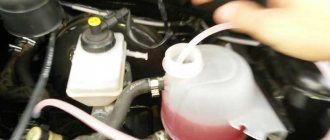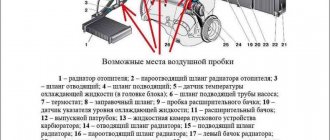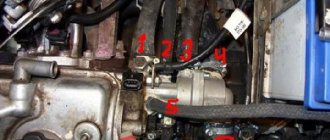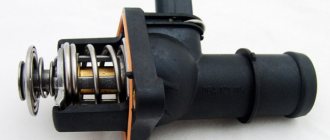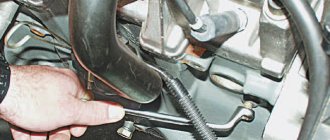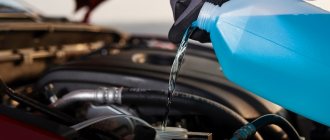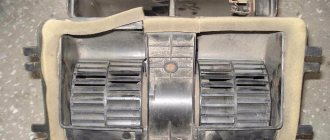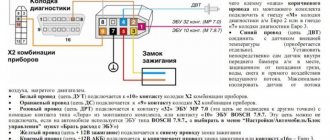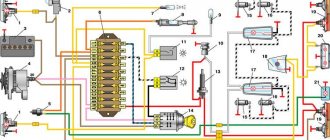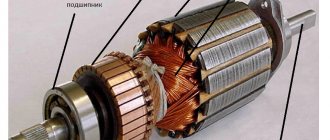The presence of air in the car's cooling system causes problems with engine overheating and ineffective operation of the interior heater. This article will present 4 methods by which it will become clear how to expel air from the cooling system of a VAZ 2114. The methods for solving the problem described in this article can be used on the entire family of first and second Samaras.
Useful video:
How to properly remove an air lock from the cooling system?
According to the law of physics, air accumulates in the highest place. In a car, the highest link in the coolant chain is the throttle body. That is why the air must be removed from there. There are several ways to get rid of an air lock.
Here is the first one. If you have a 1.6 liter engine, then:
- First of all, we remove the plastic cover on the engine - unscrew the cap on the engine to fill the oil, and then pull out the entire cover. It is seated on rubber seals.
- After removing this plastic screen, screw the oil cap back on to prevent dirt from getting into the crankcase.
- We find the heating pipes for the throttle assembly (there are 2 of them), see the figure. Pick up any phone.
- Next, unscrew the cap of the expansion tank (coolant reservoir) and cover the neck of the tank with a clean rag.
- We begin to blow into the tank with liquid. We blow until all the air comes out of the hose and antifreeze flows out.
- We quickly put the tube back on and tighten it with a clamp so that no air gets in.
(It is worth noting that depending on the tube that you removed, antifreeze may leak from both the tube and the fitting from which the tube was removed).
The second method of removing air from the cooling system is less perverted. There is no need to blow anything here:
- Warm up the engine to operating temperature.
- Warming up, turn off the engine.
- The expansion tank cap does NOT need to be unscrewed.
- As in the first method, unscrew the clamp of the coolant pipe on the throttle assembly.
- Having removed the heating pipe of the throttle assembly, release the air, and after the antifreeze begins to flow out, immediately put it back on the fitting and secure it well with a clamp.
But be careful and careful! Don't forget that the coolant temperature is approximately 90 degrees.
There is also a simpler, but less effective way to eliminate an air lock:
- We drive up a steep hill so that the radiator cap becomes the highest point of the cooling system.
- Unscrew the expansion tank cap and the radiator cap.
- Let the car warm up to operating temperature.
- Then we accelerate several times and at the same time add coolant into the barrel.
Do this until bubbles stop appearing.
Description of the operating principle of the CO
On the VAZ 2114, the same scheme is used to cool the engine as on all other injection cars. Everything is based on heat exchange with a liquid (antifreeze, antifreeze or water).
The CO device consists of the following components:
- Electric motor;
- Pump (drives liquid through the system);
- Radiator;
- Thermostat (needed to regulate the operation of all components).
Under the action of a centrifugal pump, coolant circulates through all pipes. A special fan turns on/off depending on the sensor readings. It all depends on the temperature that is currently maintained in the car. If it exceeds 87 degrees, then two things happen:
- The thermostat valve opens, coolant flows into the large circle (passes through pipes through the engine and cools it).
- The fan turns on and blows onto the radiator grilles, thus reducing the coolant temperature.
The thermostat valve is a very important element of the entire cooling system. It is made of special technical wax, which, under the influence of a certain temperature, is deformed, releasing coolant (coolant) along a large circuit. The higher the temperature, the more it deforms. Thus, the amount of coolant supply is regulated, and therefore the intensity of cooling.
Incorrect thermostat operation
Checking the thermostat in a VAZ 2114
To check its operation you need:
- Start the car and wait;
- When the engine temperature becomes high enough (reaches 97-98 degrees), you can draw certain conclusions by probing the lower pipe under the thermostat. If it is cold, it means the thermostat valve is not working properly.
Wear or lack of coolant
To replace antifreeze or antifreeze you need:
- Drain the old coolant;
- Clean the cooling system well;
- Fill with new coolant.
Many car enthusiasts have a problem with how to drain the liquid (antifreeze or antifreeze). If no big problems arise when working with an injection engine, then you will need to work a little with the radiator. Correct drainage diagram:
Checking the antifreeze level in the expansion tank
- Remove the engine protection;
- Move the stove temperature control to the far left position (highest temperature).
- Open the expansion tank;
- Place a container under the radiator to drain;
- Open the drain plug (try to do everything very slowly and carefully so as not to flood the generator);
- We wait about ten minutes.
After you have drained all the coolant, close all the plugs and fill with distilled water. Without overheating the engine, let it run for 10 minutes at low speed. Then turn it off and let it sit for another 10 minutes. If after draining the water is still dirty, the procedure must be repeated. We do this until the water becomes clear.
Violation of tightness in CO
The whole “salt” is that in a closed space, such as a cooling system, the boiling point becomes 130 degrees, and under normal conditions – 108. So any defect in the tightness can greatly affect the operation of the CO.
An excellent solution is to purchase a special antifreeze with fluorescent additives. Thanks to them, the liquid glows in ultraviolet light and it will be much easier to find the crack.
In most cases, all the necessary steps to repair the car’s vehicle can be done independently. So you can save your money and spend it on other purposes.
Cooling system features
To understand the essence of airing and the consequences that an airlock can lead to, you need to understand the cooling system itself. It is not recommended to start repairs with your own hands without having at least basic theoretical knowledge:
- VAZ-2114 cars are based on a closed liquid cooling system;
- antifreeze or antifreeze is used as a coolant;
- special channels serve to circulate coolant throughout the engine;
- circulation is carried out using a pump, which, in turn, is driven by the crankshaft through a drive belt;
- The thermostat is responsible for regulating the flow of coolant and its direction;
- the thermostat has a design that allows it to circulate in a small circle until the coolant warms up to the required parameters (in this case, the coolant does not enter the radiator);
- when the temperature reaches 87 degrees, an opening occurs and the coolant penetrates directly into the radiator;
- The radiator is blown by air flows when the car is moving;
- if natural airflow fails, then the electric fan is activated;
- a special sensor is responsible for turning it on;
- hot liquid penetrates through the heater radiator and allows the antifreeze to be warmed up in winter;
- excess antifreeze, which is formed during its thermal expansion, ends up in an additional (expansion) tank.
Preventive actions
Although getting rid of air jams is a relatively simple procedure, you need to understand that this problem is not always detected on time. This means that there is a possibility that the engine will suffer thermal shock before you notice anything unusual in its operation.
What are we getting at? It's simple - if you take simple manipulations in advance, you can avoid the appearance of air in the system.
First of all, it is necessary to check the coolant level with enviable regularity (either through the expansion tank or through the radiator filler neck). With the same frequency as you do this with motor oil. If you notice a decrease in the level, immediately add technical fluid. If you are the owner of a modern car that has at least 11G antifreeze in the radiator, you can add distilled water, but only once and in a relatively small volume.
Almost all automakers recommend performing such a check daily, although domestic drivers stubbornly ignore this advice, limiting themselves to monitoring the MM level and tire pressure.
At least once a year, before the onset of the autumn-winter season, be sure to check the density of the coolant used - it is usually indicated on the label.
Do not forget that the presence of air pockets can be assumed by monitoring the instrument readings, especially the temperature sensor. If you notice that the needle has deviated from its normal value, stop immediately to find out the reason for the engine overheating. If it was not possible to determine the malfunction, and the needle absolutely does not want to live as before, do not hesitate, go to the nearest car service center.
Causes of traffic jams
Under no circumstances should air be allowed to enter the engine cooling system. This will lead to heat transfer disturbances, which will lead to engine overheating, lack of heat inside the cabin, and more. The engine receives false information from the sensors and therefore stops functioning correctly.
If your VAZ-2114 stove is airy, there may be several reasons:
- Fixation of rubber pipes. Often the clamps become loose, which leads to a leak. Air is sucked through them, which leads to the appearance of air pockets. Most often, this phenomenon is observed in winter - sudden temperature changes compress and decompress the rubber of the pipes.
- Pump. Another fairly common reason is the pump. The problem is the same - a leak in the water pump.
- Valve. It is worth paying attention to the valve, which is built into the expansion tank (on the lid). If it freezes, it can cause airing.
- Damage to radiators. Cracks can occur on the main radiator or on the auxiliary one, that is, on the heater radiator. In these situations, the likelihood of an air lock being formed is equally high.
- Cylinder head gasket. If it burns out, the seal will be broken and air will begin to leak. As a result, there is a traffic jam in the system.
Possible causes of air congestion or the formation of an air lock include:
- damage to the pump blades;
- clogging of the cylinder block channels;
- radiator contamination.
Important! Before getting rid of the plug, be sure to eliminate the cause that caused the airing. Tighten the clamps, replace the gasket, clean the radiator, etc.
Symptoms of airiness
Diagnosing the presence of air in the cooling system is not a very difficult task, especially if you know what to pay primary attention to.
You need to start by inspecting the tightness of the connections included in the CO. All tubes together with fittings, as well as rubber hoses, are subject to inspection. They should be checked with the power unit running. Heater hoses, pipes leading to the radiator, pump, thermostat - they also cannot be ignored. Indirect signs of the presence of an air lock in the cooling system will be traces of coolant leaks. In this case, you need to tighten all the clamps, and if necessary, replace them with new ones along with leaky pipes.
Particular attention should be paid to diagnosing the thermostat, since it is subjected to serious loads during engine operation. If the engine warms up much faster than usual, and almost immediately after starting it the electric fan turns on, and after a short time the needle of the device that monitors the temperature of the power unit begins to approach the red zone, which was not observed before, you can rest assured that the problem is either a non-working thermostat , or there is airiness in the pump discharge pipe.
If the thermostat is not working, its valve will also not work, which means that when it is closed, antifreeze will circulate only through a small circuit.
The opposite situation may also arise - the engine warms up for too long, the arrow on the dashboard stands still, rooted to the spot. This means that the thermostat has broken when the valve is open, or that an air lock has formed in it.
There is a simple way to determine the degree of efficiency of the thermostat. You need to start the engine and wait until the temperature sensor needle starts moving up. Assess the condition of the radiator pipes at this moment: the lower one should be cold to the touch, the upper one should be warm. Over time, the lower one will remain the same cold, and the upper one will warm up more and more. When the coolant temperature reaches 85-90 degrees, the thermostat valve is activated, and then the lower pipe will also begin to heat up. If this does not happen, there is a malfunction.
Methods for solving the problem
If excess air is not removed from the system, this will lead to the following consequences:
- increased fuel consumption;
- low efficiency of the stove;
- engine wear;
- breakdowns.
Important! The laws of physics say that air tends to the highest point. When airing the stove on a VAZ-2114, this place will be the throttle assembly. So the traffic jam should be removed from there.
There are three methods of combating air pollution. Each of them has its own nuances.
First method
Some people perceive this method critically, but in fact it is very effective.
- Remove the filler cap through which the oil is poured. This will allow you to remove the plastic protection from the mounts (they are rubber).
- It is better to immediately screw the cap back on, otherwise you risk introducing excess dirt into the motor.
- Remove one of the tubes designed to heat the throttle. It doesn’t matter which one.
- There is a cap on the expansion tank. It should also be removed.
- Start actively blowing into this very tank. The fact that you managed to expel the air will be indicated by antifreeze or antifreeze leaking from the dismantled pipe.
- Return everything to its place as quickly as possible, tighten the tube and fix the clamp. If you hesitate, the suction will start again and you will have to repeat the procedure.
Method one
This method is a little perverted, but effective. First, you need to unscrew the oil filler cap to freely pull off the plastic protection from the rubber fasteners. After removing the protection, it is recommended to tighten the cover to prevent dirt from getting inside the engine. Next, we proceed according to the following plan: — We remove one of the throttle heating tubes (see image) — We remove the cap from the expansion tank — We blow into the tank until we expel the air and antifreeze flows from the removed tube. — We quickly put the tube in place and put on the clamp to avoid air leaks.
We expel air from the cooling system on the VAZ-2114: remove the air plug
The cooling system of any engine consists of two circuits - main and small. When air appears in the antifreeze, the small circuit practically stops working. The stove does not heat, and they look for the reason in the thermostat and change it, although it is necessary to get rid of the air lock. On injection engines, such as on the Lada VAZ-2114, it will be easy to expel air from the cooling system: the throttle assembly and access to it always remains open. There is also access to the expansion tank, and nothing else is needed.
Method three
Now we’ll tell you how to remove the air lock from the VAZ 2114 cooling system in the easiest way. It is necessary to perform a number of actions: - Drive the front wheels onto a hill or overpass - so that the highest point of the cooling system is at the level of the radiator cap - Unscrew both caps (from the tank and radiator) - Warm up the engine to 90 degrees - Give it a good throttle, adding antifreeze into the expansion tank until there are no more bubbles. This method is simple, but not always effective. But there is no need to despair. You have at least two more ways in stock.
Preparation
The 11183 engine has a plastic casing that can be removed by simply pulling the part up. You can first unscrew the oil filler plug.
Motor “11183” and its protective casing
The temperature regulator in the cabin is moved to the right position. Without this, all actions will be useless.
Using method 1, the engine is first warmed up. For methods 2 and 3, the engine is left without warming up.
Three different methods for removing air from the cooling system
Let's see how the throttle assembly on the 11183 engine is arranged. Antifreeze flows through hoses 1 and 3, and hose 2 is a tube with air (do not touch).
Pipes on the throttle assembly VAZ-11183
Method 1 (remove the hoses on the throttle body)
If the engine has been warmed up, remove either of the two hoses by placing a container under it. 100-200 ml of liquid may leak out . The hose is immediately returned to its place, the fastener is tightened, and antifreeze is added through the neck of the tank. “Method 1” is discussed here.
When working according to “method 1”, the tank is not opened at first. To loosen the fastening clamp, you will need a Phillips screwdriver. All manipulations with hot antifreeze are carried out with caution.
The first time the air usually comes out. But, if the procedure is repeated, the plug can be completely removed.
Method 2 (tank cap off)
The engine remains cold. Open the tank cap. Then we do it as in “method 1” (see photo).
Pipes on the throttle assembly of the VAZ-2111
As you can see, antifreeze does not leak. Let's help him a little:
- We take the tube, bring it to the tank and create an airtight seal with our fingers;
This method is universal. It is used on any car, including the VAZ-2114, and it is possible to expel air from the system immediately.
Method 3 (remove air without disassembling parts)
Let's consider the simplest method. You don't have to disassemble anything:
- We place the car on an overpass or hill so that the upper part of the radiator is higher than other parts;
- Open the cap on the expansion tank;
- We start the engine. The system will warm up;
- The antifreeze level may drop abruptly. The liquid is then added.
The point is that a steam exhaust hose is connected to the radiator. Air will escape through it into the tank.
Steam outlet on the tank (do not remove!)
It will be possible to increase the engine speed, but then make sure that the antifreeze does not boil . With the cover removed, this option is not excluded!
Finalization of the new cover
Unfortunately, the quality of spare parts for domestic cars leaves much to be desired, and it is better to check the new cover on a stand. If the pressure does not hold or excess pressure is not released, you can trim the springs. To do this, the part is disassembled, the sealing rubber is pryed off and removed with a screwdriver. Then use a screwdriver to carefully remove the inner cover and remove the springs.
The large spring is trimmed by one turn, and the small spring by two turns. As a result, the exhaust valve will begin to open at a pressure of 1 atmosphere, and not 1.7 atmospheres. When checking, the inlet valve should bleed freely.
Two important notes
When working according to method 1 or 2, the container is placed under both the hose and the throttle body pipe. It is not known which side the antifreeze will come from first. The brand of liquid is chosen as follows:
- Blue or green antifreeze can be diluted with antifreeze class G11 (green);
- Antifreeze class G12 (but not G11) can be added to red liquid.
Be careful: all antifreezes are usually sold in the form of a concentrate!
